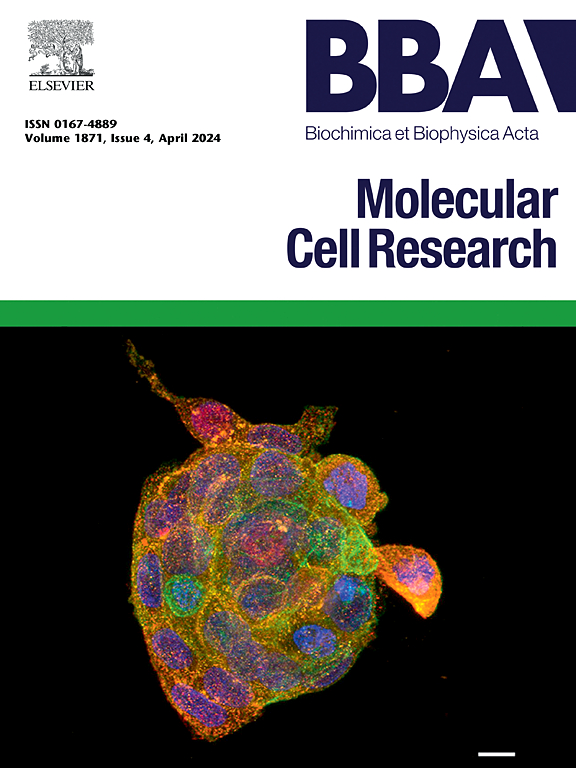VRK2激酶在癌症和神经系统疾病中的致病途径
IF 4.6
2区 生物学
Q1 BIOCHEMISTRY & MOLECULAR BIOLOGY
Biochimica et biophysica acta. Molecular cell research
Pub Date : 2025-04-03
DOI:10.1016/j.bbamcr.2025.119949
引用次数: 0
摘要
VRK2 ser-thr激酶属于暗激酶,与癌症进展、神经和精神疾病的发病机制有关。VRK2基因编码两个同工型。主要同工异构体(VRK2A)主要位于细胞质中,锚定在不同类型的膜上,如内质网、线粒体和核膜。VRK2A亚型与组装在支架蛋白(如JIP1或KSR1)上的信号模块相互作用,形成稳定的复合物,并通过改变其细胞内定位及其之间的平衡来阻断调控信号通路的激活。VRK2调节细胞凋亡、核膜组织、免疫反应和Cajal小体。野生型VRK2在肿瘤中过表达,并有助于癌症的发展。在核VRK1水平较低的细胞和肿瘤中,VRK2通过选择性剪接产生较短的同种异构体(VRK2B),该异构体缺乏c端疏水尾并允许其重新定位到细胞核中。此外,罕见的VRK2基因变异与不同的神经或精神疾病有关,如精神分裂症、癫痫、双相情感障碍、抑郁症、自闭症、生物钟改变和失眠,但其致病机制尚不清楚。这些疾病可能是由VRK2调节的不同信号通路之间平衡改变的结果。本文章由计算机程序翻译,如有差异,请以英文原文为准。
VRK2 kinase pathogenic pathways in cancer and neurological diseases
The VRK2 ser-thr kinase, belonging to the dark kinome, is implicated in the pathogenesis of cancer progression, neurological and psychiatric diseases. The VRK2 gene codes for two isoforms. The main isoform (VRK2A) is mainly located in the cytoplasm, and anchored to different types of membranes, such as the endoplasmic reticulum, mitochondria and nuclear envelope. The VRK2A isoform interacts with signaling modules assembled on scaffold proteins such as JIP1 or KSR1, forming stable complexes and blocking the activation of regulatory signaling pathways by altering their intracellular localization and the balance among them. VRK2 regulates apoptosis, nuclear membrane organization, immune responses, and Cajal bodies. Wild-type VRK2 is overexpressed in tumors and contributes to cancer development. In cells and tumors with low levels of nuclear VRK1, VRK2 generates by alternative splicing a shorter isoform (VRK2B) that lacks the C-terminal hydrophobic tail and permits its relocation to nuclei. Furthermore, rare VRK2 gene variants are associated with different neurological or psychiatric diseases such as schizophrenia, epilepsy, bipolar disorder, depression, autism, circadian clock alterations and insomnia, but their pathogenic mechanism is unknown. These diseases are a likely consequence of an altered balance among different signaling pathways that are regulated by VRK2.
求助全文
通过发布文献求助,成功后即可免费获取论文全文。
去求助
来源期刊
CiteScore
10.00
自引率
2.00%
发文量
151
审稿时长
44 days
期刊介绍:
BBA Molecular Cell Research focuses on understanding the mechanisms of cellular processes at the molecular level. These include aspects of cellular signaling, signal transduction, cell cycle, apoptosis, intracellular trafficking, secretory and endocytic pathways, biogenesis of cell organelles, cytoskeletal structures, cellular interactions, cell/tissue differentiation and cellular enzymology. Also included are studies at the interface between Cell Biology and Biophysics which apply for example novel imaging methods for characterizing cellular processes.

 求助内容:
求助内容: 应助结果提醒方式:
应助结果提醒方式:


